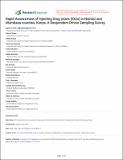| dc.contributor.author | 33. Gabriel O Dida, Francis Oguya , Francisca Ongecha, Patrick Mureithi , Helgar Musyoka, Nicholas Muraguri , Ben Mundia , Caleb Angira, Mohammed Shose, Taib A. Basheeb , Abdalla Ahmed Mohamed, , John P. Oyore , Otieno G. Ochieng , Saade Abdalla, Reychard Abdool | |
| dc.date.accessioned | 2022-02-01T12:57:02Z | |
| dc.date.available | 2022-02-01T12:57:02Z | |
| dc.date.issued | 2020 | |
| dc.identifier.uri | https://repository.maseno.ac.ke/handle/123456789/4840 | |
| dc.description | DOI: https://doi.org/10.21203/rs.3.rs-44785/v1 | en_US |
| dc.description.abstract | Background: A Cross-sectional Rapid Situational Assessment of Injecting Drug Users (IDUs) applying Respondent Driven sampling techniques (RDS)
was used to recruit subjects/participants in a study aimed at assessing HIV prevalence and risk behaviors among injection drug users in Nairobi and
Mombasa counties of Kenya. The study sought to establish HIV prevalence and document risk behaviors among IDUs in the two regions, as well as
assess their spatial distribution and size estimates in the general population.
Methods: A cross-sectional study design was adopted in which a set of initial subjects referred to as ‘seeds’ were first identified from which an
expanding chain of referrals was obtained, with subjects from each wave referring subjects of subsequent wave. The seeds were drawn randomly
from the population and interviewed to pick the one with the largest network and other unique characteristics. A maximum of twelve seeds were
recruited. The second stage involved conducting assessment visits to the sites to identify potential collaborators that included non-governmental
organizations (NGOs), drug treatment centres, health facilities, Community based organizations (CBO's), among others. Three NGOs located in the
Mombasa county and one in Nairobi county were identified to assist in identifying drug injection locations and potential participants. Key informant
interviews (KIIs) and Focus Group Discussions (FGDs) were also conducted using interview guides.
Results: A total of 646 individuals (344 in Nairobi and 302 at the coast) were recruited for the study between January and March 2010. Of these 590
(91%) were males and 56 (9%) were female. Findings showed that most IDUs initiated injecting drug use between the ages of 20-29 years, with the
youngest age of initiation being 11 years and oldest age being 53 years. Most commonly injected drug was heroin (98%), with a small (2%)
percentage injecting cocaine. Other non-injecting methods such as smoking or combining these two drugs with other drugs such as cannabis or
rohypnol were also common. Most IDUs used other substances (cigarettes, alcohol, and cannabis) before initiating injecting drug use. While all IDUs
continue to be at risk in the two regions, those from the Western parts of Nairobi were at a relatively higher risk given their higher rate of sharing
injecting equipment and solutions.
Conclusions: Given that initiation of injection drug use begins early and peaks mainly after formal school years (20-29 years), preventive programmes
should be targeted at secondary school, college and out of school youth. Further, to protect People who inject drugs (PWIDs) from HIV infection, the
country should introduce free Needle Syringe Programs with provision of condoms and Methadone Assisted Therapy as a substitute for drug use | en_US |
| dc.publisher | research square | en_US |
| dc.subject | HIV-related behaviors, Injection drug users (IDUs), Mombasa, Nairobi, Respondent Driven Sampling, Kenya | en_US |
| dc.title | Rapid Assessment of Injecting Drug Users (IDUs) in Nairobi and Mombasa counties, Kenya: A Respondent Driven Sampling Survey | en_US |
| dc.type | Article | en_US |

